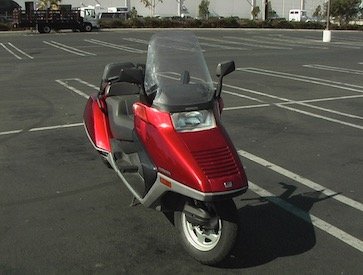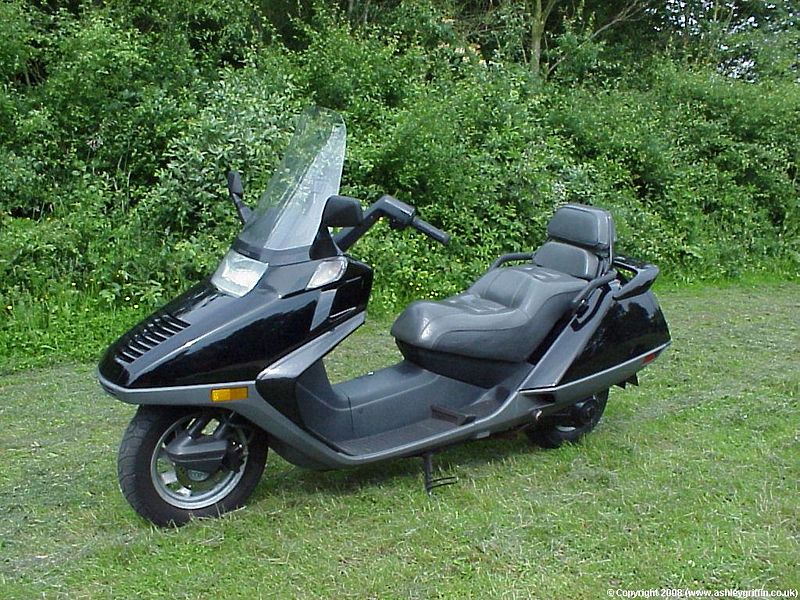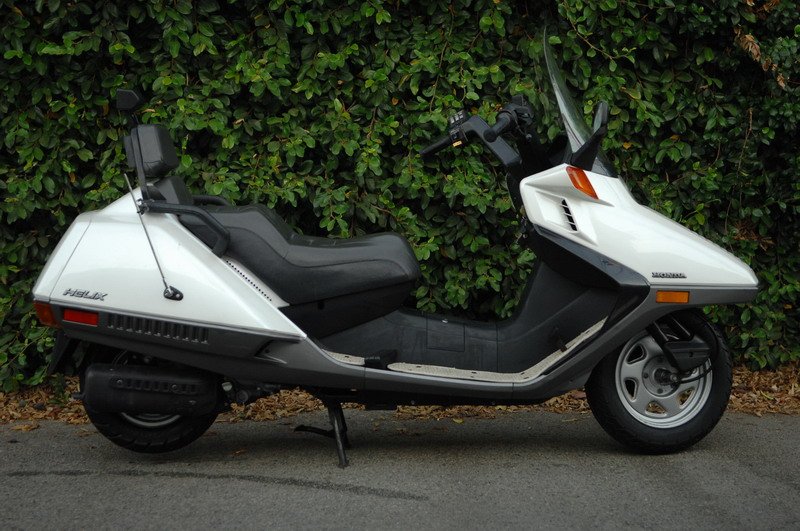HONDA HELIX (CN250)
Longer, lower and better for touring than any scooter to date, the Helix was a landmark scooter than inspired many of today’s maxi-scooters. Take a look at Yamaha’s Morphous or Suzuki’s Burgman and the same long shape is easily seen. The Helix was the first scooter to feature a rear trunk and its decent size, along with a nice glovebox, makes longer rides more feasible.
The intention of the Helix was to address the shortcomings that hinder scooters on the highway like short wheelbases, limited storage, mediocre brakes and marginal comfort. The Helix was introduced into the USA and Canadian markets for the 1986 (a year after the Elite 250) but it was dropped from the Canadian lineup after just one year. Accordingly, the Helix is a common scooter in the USA but rather rare in Canada. Outside North American the Helix is known as the Fusion and Spazio.

After ten years, Honda dropped the Helix for 2002 since they had introduced a similar scooter, the Reflex, for 2001. The Reflex was a nice scooter but enthusiasts in Japan clamoured to have the Helix back, so Honda brought it back worldwide and sold it alongside the Reflex (aka Forza) in 2003. Honda sold both of these scooters until they were concurrently dropped after the 2007 model year. It’s a strong testament to the awesomeness of the Helix that it was able to sell alongside the newer Reflex for a similar price.
 Motor
Motor
The Helix shares the same basic engine as its more traditionally styled sibling, the Elite 250. This 244cc vertical engine was used in the 1985 – 1988 Elite 250’s before the Elite 250 got a new horizontal motor that never was introduced to the Helix.
The Helix’s motor was a low stressed, 2-valve 4-stroke engine that used liquid cooling to keep the temperatures steady on all day high speed rides. This motor offered exceptional reliability and even today in its old age is still often a strong performer. Top speed for the Helix was about 75mph and it cruised comfortable at 65-70mph while achieving around 65 mpg. The top speed of the Helix is slightly faster than the Elite 250, as the Helix is more aerodynamic.
Design and Amenities
The Helix has a foot pedal for the rear brake like the larger Elite scooters. It’s a little odd to use at first but you do get used to it. Up front, the Helix uses a disc brake which was big news for its time. When it was introduced the Helix was the only Honda scooter with a front disc brake, as the Elite scooters all used a drum brake up front in North America.
The Helix offers a generous amount of storage, with a rear trunk made possible by its long design. The stretched out length of the Helix allowed Honda to add the first ever rear trunk to a scooter, which was a radical concept at the time. In addition to being long the Helix was also low, with a record setting 26.2” low seat. Despite newer generations of maxi-scooters, the Helix still has perhaps the longest wheelbase of any scooter at 63.8”. Even big maxi scooters like the Burgman 650 come up an inch short on this.
Discussion
The only changes Honda made to the Helix over its long run were improved emissions controls to meet new regulations and aluminum rims instead of steel for 1992. Accordingly, finding parts for the Helix is quite easy and you don’t really have to worry about compatibility. Honda still provides strong OEM parts support and they will continue to do so for a long time as the Helix was sold until 2007. There are also a lot of aftermarket parts for the Helix (mostly appearance parts). Check out the links at the bottom of this page to find out more.
The closest competitor to the Helix is Yamaha’s Morphous scooter, which bears a lot of resemblance to the Helix in a newer design. The Morphous is spiritually the follow up generation to the Helix which Honda never bothered to design. The Morphous was sold from 2006 – 2008 and may be a good fit for anyone looking for a newer scooter than the Helix. While the Helix was sold until 2007, it was a slow seller for most of its run other than the 80’s, so most examples are older.
A few other options are Kymco’s Grandvista 250 and Downtown 200i / 300i scooters. These newer scooters from Kymco are nice options for the open road that aren’t quite as long, low and unique as the Helix, but they are nicely designed highway capable scooters that still offer a cheaper and lighter package than a full sized maxi. As well, Honda’s new 300cc Forza scooter represents a great touring machine in the same vein as the Helix, albeit at a higher cost.
Pros:
- Comfortable
- Awesome storage capacity
- Cult following
- Liquid cooled
- Front Disc Brake
Cons:
- Dated styling compared to modern competitors
- Short rear tire life (due to small circumference)
Links:
Helix Service Manual – Essential for working on your own scooter
MotorscooterGuide Forums – Visit the forum on this site to chat about your scoot.
Motorcycle.com Review – Good writeup of the Helix.
YouTube Review – Nice video walk-around and tour
HelixParts.com – Lots of fancy aftermarket parts
Helix Colors:
- 1986: Candy Glory Red, Pearl Shell White
- 1987: Candy Glory Red, Achilles Black Metallic
- 1992 – ’93: Candy Glory Red
- 1994: Gloss Black-Z
- 1995: Gloss Black
- 1996 – 2000: Pure Red
- 2001: Black
- 2005: Black, Pearl White
- 2006: Red
- 2007: Red
Key Specs:
- Manufacturer: Honda
- Model: CN250 Helix
- Aliases: Fusion, Spazio
- Engine: 244cc, Liquid-cooled, four-stroke single
- Power: 19hp @ 7500 RPM, 15.5 lbs-ft @ 5000 RPM
- Carburetion: 30.0mm CV with auto choke
- Compression: 9.8:1
- Bore x stroke: 72.0 x 60.0 mm (2.8 x 2.4 inches)
- Fuel system: Keihin Carb.
- Displacement: 244cc
- Carburetion: 30mm CV with automatic choke
- Transmission: Automatic V-Matic
- Suspension: 3.2” Bottom Link (front), 3.9” travel dual hydraulic shocks
- Wheelbase: 63.8”
- Seat height: 26.2”
- Dimensions: L x W x H = 2265mm (89.2″) x 745mm (29.3″) x 1355mm (53.5mm)
- Tires: 110/100-12 9 (front), 120/90-10 (rear)
- Fuel capacity: 3.2 gal.
- Weight: 349.4 lbs (Dry)
- MSRP: $2598 (1987)



 Motor
Motor
